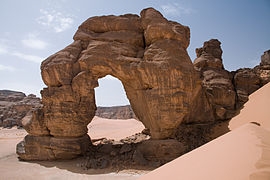Great Kavir
| This article is a stub. You can help IxWiki by expanding it. |
The Great Kavir (Kaveer meaning "wasteland" in Arabic) is a desert spanning across Battganuur, Bulkh, Pursat, and Umardwal in Daria, Audonia. Some 5,000 years ago, the area was not so arid and the vegetation might have been closer to a savanna. However, desertification set in around 3000 BCE, and the desert became much like it is today. The Great Kavir is mainly rocky stone plateaus (hamada); sand seas – large areas covered with sand dunes (ergs); gravel plains (reg); dry valleys (wadi); dry lakes (oued); and salt flats (shatt or chott).
There is an international reclamation project called the Great Green Wall occurring in Battganuur, Bulkh, and Pursat, with investment from Burgundie to green, rewild, and de-desertify the edge of the desert to reclaim arable land.
Human intervention
Water
In the 2020s Burgo-Bulkhawan researchers, using the Great Kavir Research and Sovereignty Patrol Structure found three massive aquifers under the Great Kavir, one in central Bulkh, one on the southern Battganuuri-Bulkhawan border, and one on the northern Bulkhawan-Umardi border. There are an estimated 47 trillion gallons in these three aquifers. The Bahr al-Sahra, in central Bulkh, estimated at 13 trillion gallons, was tapped to be the first to exploit. There was determined to be a higher-than-acceptable levels of nitrogen in the groundwater, so wells built with intricate filtration systems were built.
Culture
Gallery
-
Salt flats in Bulkh










